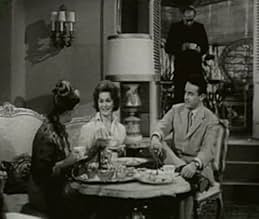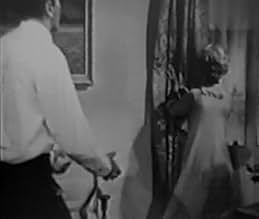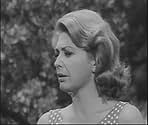A collection of tales about paranormal events, horrifying folklore, and the world of the unknown.A collection of tales about paranormal events, horrifying folklore, and the world of the unknown.A collection of tales about paranormal events, horrifying folklore, and the world of the unknown.
Browse episodes
Featured reviews
Anyone who has ever had a chance to see any of the original episodes of One Step Beyond has truly experienced great television, the way it should be even today in our so called "state of the art" world.
It really doesn't take a whole lot to make a great, convincing program. The mood and music and stories behind each episode is disturbing even now. My hubby found a 2 CD box set of the series that only cost us $5.00! But what great episodes they are. I would really like to own all of the series, if they are still available.
Once again, One Step Beyond was real television. Forget about the new reality shows of today. I'll gladly take one step beyond back to the way real great t.v. shows were meant to be.
It really doesn't take a whole lot to make a great, convincing program. The mood and music and stories behind each episode is disturbing even now. My hubby found a 2 CD box set of the series that only cost us $5.00! But what great episodes they are. I would really like to own all of the series, if they are still available.
Once again, One Step Beyond was real television. Forget about the new reality shows of today. I'll gladly take one step beyond back to the way real great t.v. shows were meant to be.
I was born five years before Alcoa produced this wonderful series - and it is wonderful, even though I remain thoroughly skeptical about the "truth" of the stories that were presented. Hosted by John Newland, in a quiet, thoughtful, and urbane manner, it presented different types of occult phenomenon each week, in well produced half-hour shows. I did not see it until the 1960s, when it was in syndication as reruns. But it was certainly entertaining and creepy. I won't dare to rate it against THE TWILIGHT ZONE or THE OUTER LIMITS (in particular as they were outwardly fictional and frequently entered science fiction), but it was one of the top horror shows in television history.
Newland would come out with his weekly introduction - just like Rod Sterling or Alfred Hitchcock on their shows. Sometimes he would bring a small prop or item related to the story. On one show he brings out an old watch, which he will look at several times in the half hour, telling the time on it. He says to the audience, when he first looks at it, "J.W.B. Those are the initials of the owner of this watch. They are the initials of a murderer." The episode that follows deals with the assassination of Abraham Lincoln (the watch being John Wilkes Booth's). It is not a simple retelling of the story of Lincoln's death. The episode describes the odd premonitions and signs that reportedly happened in Washington, D.C. on that date, and around the country. For example, Lincoln's relating several eerie dreams he had (one of which was of him in the East Room, being told that the visitors there were in mourning for the President - who had been assassinated).
There were many odd stories. In one Donald Pleasance was a successful barrister, about to become a high court justice in Great Britain, when he is confronted by evidence that only he can understand that shows how he allowed an innocent man to be hanged years earlier at the start of his career (he was the prosecutor). Supposedly the truth was told to him by the so-called murdered woman (apparently not so murdered as she was supposed), but he never reported it to the authorities. Twenty years later and evidence that he destroyed reappears, forcing him to confess - and driving him insane in the end (he becomes a madman addressing the crowds in Hyde Park daily relating his evil act).
An episode with Patrick Macnee about premonitions regarding the sinking of the Titanic ends with a reference which I can vouch for is true - that in 1898 Mr. Morgan Robinson wrote a novella, FUTILITY: THE WRECK OF THE TITAN, about the world's greatest ocean liner being sunk by an iceberg on it's maiden voyage with great loss of life. Another episode with Werner Klemperer dealt with an unrepentant Nazi, pursued by some malevolent spirit on a U-boat, who causes so much noise that the U-boat is forced to surrender to an allied naval craft or be blown out of the water. There was one curious episode about an evil aristocrat's diamond choker that picked up the vibes from her personality, and choked her to death (and later killed her maid who stole the choker as well). Elizabeth Montgomery played a young flirt on an old west cavalry post, who thoughtlessly forces a young officer to do a dangerous assignment that kills him, and yet, weeks later when the post has a regimental ball, is confronted before everyone by his ghost who dances with her until she dies.
So it went on these episodes. Even if, like myself, you did not believe in the phenomenon that Newland's stories presented (and he never forced anyone to believe them) you got into the mood and watched some interesting stories, and some first rate acting (William Shatner, Charles Bronson, and Edward Binns were three other actors who appeared on the show). For a really spooky, but enjoyable experience, ONE STEP BEYOND was very hard to beat.
Newland would come out with his weekly introduction - just like Rod Sterling or Alfred Hitchcock on their shows. Sometimes he would bring a small prop or item related to the story. On one show he brings out an old watch, which he will look at several times in the half hour, telling the time on it. He says to the audience, when he first looks at it, "J.W.B. Those are the initials of the owner of this watch. They are the initials of a murderer." The episode that follows deals with the assassination of Abraham Lincoln (the watch being John Wilkes Booth's). It is not a simple retelling of the story of Lincoln's death. The episode describes the odd premonitions and signs that reportedly happened in Washington, D.C. on that date, and around the country. For example, Lincoln's relating several eerie dreams he had (one of which was of him in the East Room, being told that the visitors there were in mourning for the President - who had been assassinated).
There were many odd stories. In one Donald Pleasance was a successful barrister, about to become a high court justice in Great Britain, when he is confronted by evidence that only he can understand that shows how he allowed an innocent man to be hanged years earlier at the start of his career (he was the prosecutor). Supposedly the truth was told to him by the so-called murdered woman (apparently not so murdered as she was supposed), but he never reported it to the authorities. Twenty years later and evidence that he destroyed reappears, forcing him to confess - and driving him insane in the end (he becomes a madman addressing the crowds in Hyde Park daily relating his evil act).
An episode with Patrick Macnee about premonitions regarding the sinking of the Titanic ends with a reference which I can vouch for is true - that in 1898 Mr. Morgan Robinson wrote a novella, FUTILITY: THE WRECK OF THE TITAN, about the world's greatest ocean liner being sunk by an iceberg on it's maiden voyage with great loss of life. Another episode with Werner Klemperer dealt with an unrepentant Nazi, pursued by some malevolent spirit on a U-boat, who causes so much noise that the U-boat is forced to surrender to an allied naval craft or be blown out of the water. There was one curious episode about an evil aristocrat's diamond choker that picked up the vibes from her personality, and choked her to death (and later killed her maid who stole the choker as well). Elizabeth Montgomery played a young flirt on an old west cavalry post, who thoughtlessly forces a young officer to do a dangerous assignment that kills him, and yet, weeks later when the post has a regimental ball, is confronted before everyone by his ghost who dances with her until she dies.
So it went on these episodes. Even if, like myself, you did not believe in the phenomenon that Newland's stories presented (and he never forced anyone to believe them) you got into the mood and watched some interesting stories, and some first rate acting (William Shatner, Charles Bronson, and Edward Binns were three other actors who appeared on the show). For a really spooky, but enjoyable experience, ONE STEP BEYOND was very hard to beat.
There have been so many comparisons between this show and The Twilight Zone I may as well add my own two cents on the subject. These two shows were both hosted and created by men who had been active in live television. Rod Serling had been one of the top writers of the live so-called "golden age" of TV drama in the fifties, while John Newland had been a prominent actor on the small screen during the same period. Alcoa Presents (rerun as One Step Step Beyond, and best-remembered by this title) actually preceded the Zone by half a second, and ran for less than three full years. TZ has a bigger cult audience, but OSB (as I prefer to call it), has its admirers, of which I am one.
The Zone was liberal in tone, dark and moody in its photographic style. Its set designs, particularly its street scenes, were reminiscent of film noir. While the Zone's stories were all fiction, many adapted from short stories, OSB's producers claimed that its stories were all based on fact. The different styles of the two shows can be seen in the way their hosts presented themselves. Serling was dark, intense, urban and verbose. Newland was light, mild, laconic and somewhat effete. While Serling seemed like the sort of guy you'd see at the ballpark or at the fights, Newland was the kind of guy one might expect to turn up at the opera. Serling came off as very American in all respects, while Newland could almost pass as British.
OSB presented each episode as if it were the truth, only slightly dramatized. There was nothing on the surface to suggest that the show was in any way about the supernatural or ESP. The sets were unimaginative, prosaic, and often seemed flooded with light; as the overall visual style of the series was not that different from a commercial,--or an episode of the Loretta Young Show. What made the shows creepy were the acting, which was often excellent, and Harry Lubin's eerie, otherworldly music, which kicked in whenever something weird was happening. The actors tended to react to the strange goings-on realistically,--as it they were choking to death, had just seen a ghost, talked to a dead person or had witnessed a murder that had happened twenty years earlier--and the "startle reactions" on the faces of the players, plus Lubin's beyond the grave music, could send chills down one spine. This was a million miles from the often sentimental and didactic Zone, which seldom went for straight horror, straight sci-fi or straight anything unless there was a "meaning" (i.e. a point, a lesson), while the only lesson one learned from OSB was that "such things exist, such things happen". Chilling television, this was, and story-telling with a vengeance. "You want meaning?", Newland seemed to ask the viewer after each episode, "Go find it for yourself. My job is to give you the facts".
The Zone was liberal in tone, dark and moody in its photographic style. Its set designs, particularly its street scenes, were reminiscent of film noir. While the Zone's stories were all fiction, many adapted from short stories, OSB's producers claimed that its stories were all based on fact. The different styles of the two shows can be seen in the way their hosts presented themselves. Serling was dark, intense, urban and verbose. Newland was light, mild, laconic and somewhat effete. While Serling seemed like the sort of guy you'd see at the ballpark or at the fights, Newland was the kind of guy one might expect to turn up at the opera. Serling came off as very American in all respects, while Newland could almost pass as British.
OSB presented each episode as if it were the truth, only slightly dramatized. There was nothing on the surface to suggest that the show was in any way about the supernatural or ESP. The sets were unimaginative, prosaic, and often seemed flooded with light; as the overall visual style of the series was not that different from a commercial,--or an episode of the Loretta Young Show. What made the shows creepy were the acting, which was often excellent, and Harry Lubin's eerie, otherworldly music, which kicked in whenever something weird was happening. The actors tended to react to the strange goings-on realistically,--as it they were choking to death, had just seen a ghost, talked to a dead person or had witnessed a murder that had happened twenty years earlier--and the "startle reactions" on the faces of the players, plus Lubin's beyond the grave music, could send chills down one spine. This was a million miles from the often sentimental and didactic Zone, which seldom went for straight horror, straight sci-fi or straight anything unless there was a "meaning" (i.e. a point, a lesson), while the only lesson one learned from OSB was that "such things exist, such things happen". Chilling television, this was, and story-telling with a vengeance. "You want meaning?", Newland seemed to ask the viewer after each episode, "Go find it for yourself. My job is to give you the facts".
I do not understand the debate about the Twilight Zone and One Step Beyond. Both were excellent in their own rights. If both were on at the same time, I would watch one and tape the other. True horror fans of the anthology shows would see that these are two entirely different beasts. OSB is fictionalized accounts of supposedly true events. The creepiest One Step Beyond episode that I ever saw involved some German young people who were into gliders before WWII. One gets jealous and kills one who kissed his girlfriend before taking off in the glider. He stabs him and the glider disappears. The made a pact before hand to meet back after the war.Lo and behold the glider returns on that day with the survivors there. That was creepy!The horror wasn't really shown on screen which is a testament to the writing and creativity of the stories and the show. I just wish I could find old episodes to buy or rent. The show was just that good.
10penwil09
I am a connoisseur of "horror" movies/series, and have seen them all since the 1950s, but One Step Beyond remains the scariest of all the series. The only one that came close was Boris Karloffs'-Thriller! John Newlands' beginning monologue reels you in, to have you gripping the arms of your chair during the story, too scared out of your wits to even move, then having the story ending to Mr.Newlands epilogue to further heighten your anxiety of being too fearful to go to sleep!! Unlike..Twilight Zone, Hitchcock, Night Gallery,Tales from the Crypt, Outer Limits and X-Files which ALL have humorous episodes which discount their "scare-quotient", and leaves you disappointed....however "O.S.B."satisfies the most discriminating of "scary-movie" tastes !!! O.S.B never had one "hokey" episode that would tickle your funny bone and that is what makes for excellent scare tactics. I wish they had this series on DVD !!!
Did you know
- TriviaThrough an oversight, Worldvision didn't renew the copyrights on most episodes of this series when they expired in the late 1980s, and they thus fell into the public domain. Since royalties didn't have to be paid to Worldvision, the result was a revival of the series on UHF and cable television and on VHS and DVD. Since well-worn syndication prints were and are typically used by those media, the results often leave something to be desired, quality-wise. Despite the public domain status for most episodes, the series' remaining copyrights belongs to its distributor CBS Television Distribution. CTD is the successor to the series' previous distributors, which include ABC Films successor Worldvision Enterprises and CTD's predecessor Paramount Domestic Television.
- Quotes
John Newland: [episode introduction] What you are about to see is a matter of human record. Explain it: we cannot. Disprove it: we cannot. We simply invite you to explore with us the amazing world of the Unknown... to take that One Step... Beyond.
- Alternate versionsWhen this was run on network television (ABC), it was titled "Alcoa Presents: One Step Beyond." The 16mm television syndication prints carry the title of simply "One Step Beyond."
- ConnectionsFeatured in Television: The First Fifty Years (1999)
- How many seasons does One Step Beyond have?Powered by Alexa
Details
- Runtime25 minutes
- Color
- Aspect ratio
- 1.33 : 1
Contribute to this page
Suggest an edit or add missing content







































